As cat owners, we’re no strangers to the occasional hairball or vomiting episode. But when your feline friend starts throwing up food while acting normal, it’s easy to brush it off as just another day in the life of a cat. However, persistent vomiting can be a sign of an underlying issue that needs attention.
In this blog post, we’ll dive into the reasons why your cat may be throwing up food. We’ll start with the common culprits like gobbling down meals too quickly or ingesting something they shouldn’t have. But we’ll also explore more serious health conditions that could be causing the vomiting.
While your cat may seem perfectly fine despite their vomiting, it’s important to keep an eye out for any red flags. We’ll discuss what signs to look for and when it’s time to take action by visiting your veterinarian.
So, grab a cup of coffee and join us as we embark on this journey through the world of feline health.
In this post, you’ll have all the information you need to determine whether your kitty is just being a typical cat or if there’s something more serious going on.
Reasons Why Cats Vomit After Eating
Unveiling the Possible Reasons
You know that cats can be finicky when it comes to their food choices. However, when your cat vomits after eating, it can be alarming and raise concerns about their health. In this article, we will explore some of the reasons why cats vomit after eating and what you can do to help them.
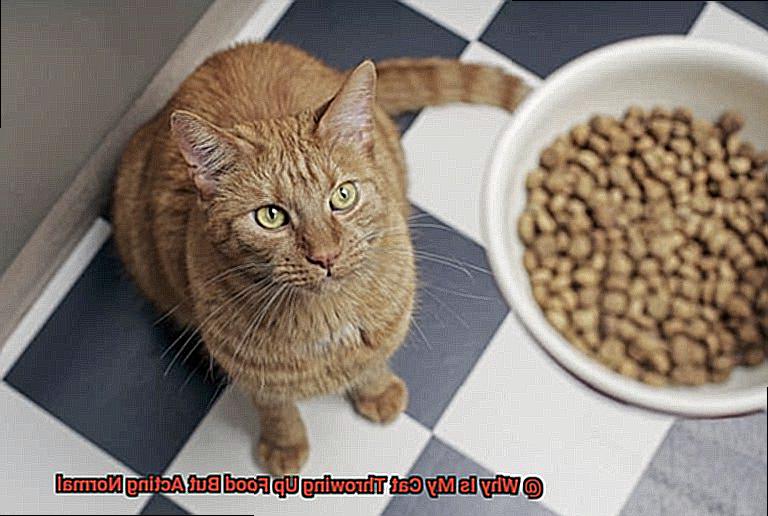
Hairballs
We all know that cats are fastidious groomers and tend to swallow hair during self-grooming. Hairballs are a common cause of vomiting in cats. When hairballs form in their stomach, they can cause irritation and discomfort, leading to vomiting. If your cat is vomiting frequently and hasn’t expelled a hairball, it may need medical attention.
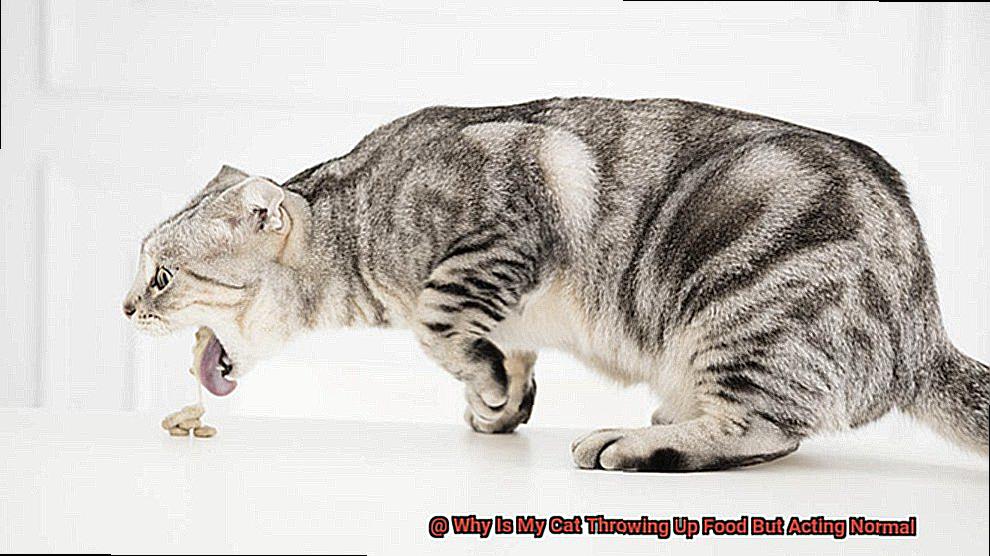
Overeating
Cats are known for their love of food and can eat voraciously. However, overeating can cause vomiting in cats. When cats eat too much at once, their stomach becomes overloaded, leading to vomiting. Feeding your cat smaller portions more frequently throughout the day or using a slow feeder bowl to slow down their eating can help prevent overeating.
Allergies
Cats can develop food allergies to certain ingredients in their food, which can trigger vomiting after eating. If you notice your cat consistently vomiting after eating a specific food, it may be due to an allergy. Consult with your veterinarian to determine the cause of the allergy and how to manage it.
Infections
Gastrointestinal infections caused by viruses, bacteria or parasites can cause vomiting in cats. Infections can lead to dehydration and other health problems if not treated promptly. If your cat is consistently vomiting after eating or showing other concerning symptoms like diarrhea or lethargy, seek veterinary care immediately.
Medical Conditions
Certain medical conditions such as pancreatitis or inflammatory bowel disease can cause vomiting after eating. If you notice your cat consistently vomiting after eating and showing other concerning symptoms like weight loss, it may be a sign of an underlying condition. Seek veterinary care to determine the cause of the issue.
In conclusion, while occasional vomiting may be normal for cats, persistent vomiting after eating can indicate an underlying health issue. By understanding the reasons behind their vomiting, you can take appropriate measures to ensure your cat’s health and well-being.
How to Prevent Vomiting in Cats
Fortunately, there are several ways to prevent frequent vomiting in cats. Here are five simple yet effective tips on how to prevent vomiting in cats:
Feed Your Cat Smaller Meals
Feeding your cat smaller meals throughout the day is a great way to prevent vomiting. Smaller meals are easier for your cat’s stomach to digest, which reduces the likelihood of vomiting.
Additionally, this feeding schedule can help regulate your cat’s appetite and prevent overeating.
Avoid Sudden Changes in Diet
Cats are creatures of habit, and sudden changes in their diet can cause vomiting. If you need to change your cat’s diet, do it gradually over a period of several days. This gradual transition will give your cat’s digestive system time to adjust and prevent any potential digestive issues.
Monitor Your Cat’s Eating Habits
Observe your cat while they eat and make sure they are not eating too quickly or too much at once. Cats that eat too quickly or too much may vomit shortly after eating. Consider using slow-feeding bowls or scatter feeding toys to encourage slower eating and more mental stimulation.
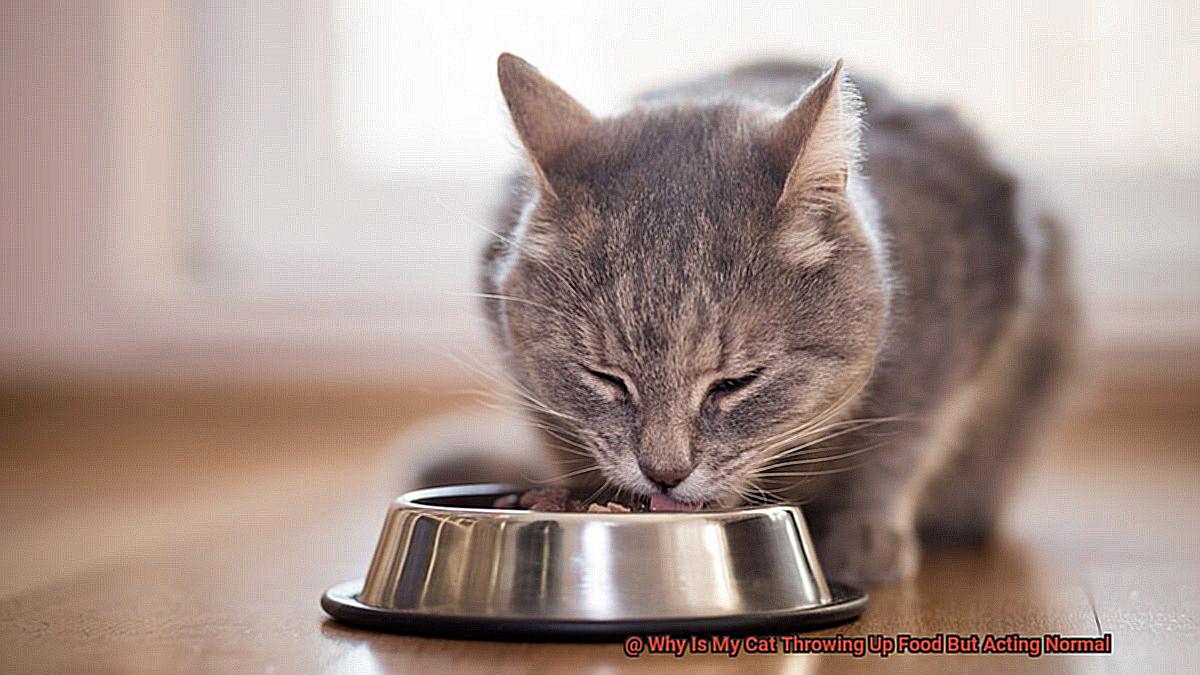
Keep Your Cat Hydrated
Dehydration can cause vomiting, so make sure your cat always has access to fresh water. You can also add water to their food to help keep them hydrated. If your cat is hesitant to drink water, consider investing in a pet fountain or adding low-sodium chicken broth to their water bowl.
Reduce Stress
Stress can cause vomiting in cats, so try to reduce any stressors in your cat’s environment. Provide plenty of hiding places, scratching posts, and toys for mental stimulation, and ensure that their litter box is clean and easily accessible.
Signs of Hairballs and How to Treat Them
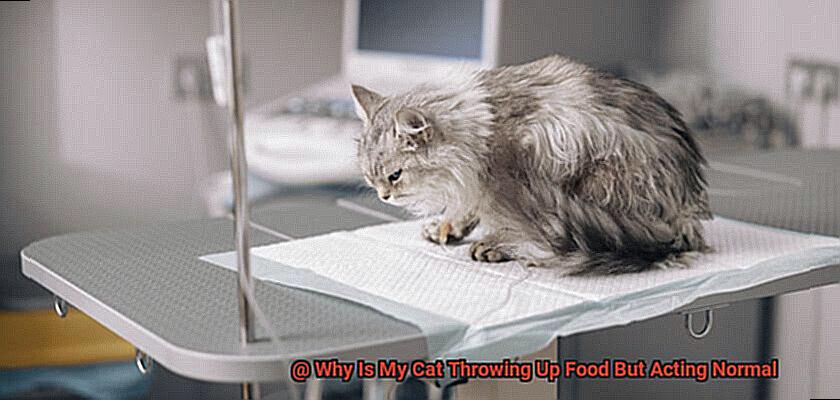
However, hairballs can be a common and uncomfortable issue for cats. Hairballs form when cats ingest their own fur while grooming, and the fur accumulates in their stomachs. This can lead to irritation, discomfort, and even vomiting. Long-haired cats are particularly susceptible to hairballs, but all cats can experience them.
One of the most noticeable signs is frequent vomiting, especially if the vomit contains hair. Your cat may also cough or gag as if trying to clear something from their throat. In addition, they may have a decreased appetite or seem lethargic.
Fortunately, there are several ways to treat and prevent hairballs in cats. Regularly brushing your cat can help remove loose fur before it can be ingested. You can also provide your cat with specialized hairball prevention food or treats that contain fiber or oils to help move hair through their digestive system.
If your cat already has a hairball, there are at-home remedies that you can try to help them pass it. For example, providing a small amount of petroleum jelly or another lubricant can help the hair pass more easily. Canned pumpkin can also act as a natural laxative.
However, if your cat is vomiting frequently or seems to be in pain, it’s important to take them to the vet for an examination. In some cases, hairballs can become problematic and require veterinary intervention.
Your vet may recommend medication or even surgery if necessary to help resolve the issue.
Pancreatitis and Inflammatory Bowel Disease as Causes of Vomiting
While hairballs are a common and harmless cause of vomiting in cats, it’s crucial to be aware of more serious conditions that can lead to this unpleasant symptom, such as pancreatitis and Inflammatory Bowel Disease (IBD).
Pancreatitis is an inflammation of the pancreas that can cause digestive enzymes to leak out and damage surrounding tissue. This can lead to vomiting, abdominal pain, and diarrhea in cats. On the other hand, IBD is a chronic condition that causes inflammation in the digestive tract leading to symptoms like vomiting, weight loss, poor appetite, and diarrhea.
If you notice that your cat is experiencing frequent vomiting episodes but appears otherwise healthy and normal, it’s worth considering pancreatitis or IBD as potential causes. Additionally, watch out for lethargy, decreased appetite, and changes in bowel movements as these may be indicative of these conditions.
To diagnose pancreatitis or IBD, your veterinarian may perform blood tests, fecal exams, or imaging studies such as X-rays or ultrasounds. Treatment may involve medication to manage symptoms and address underlying inflammation, as well as dietary changes to support digestive health.
It’s essential to act promptly when treating pancreatitis and IBD in cats since they can lead to serious complications if left untreated.
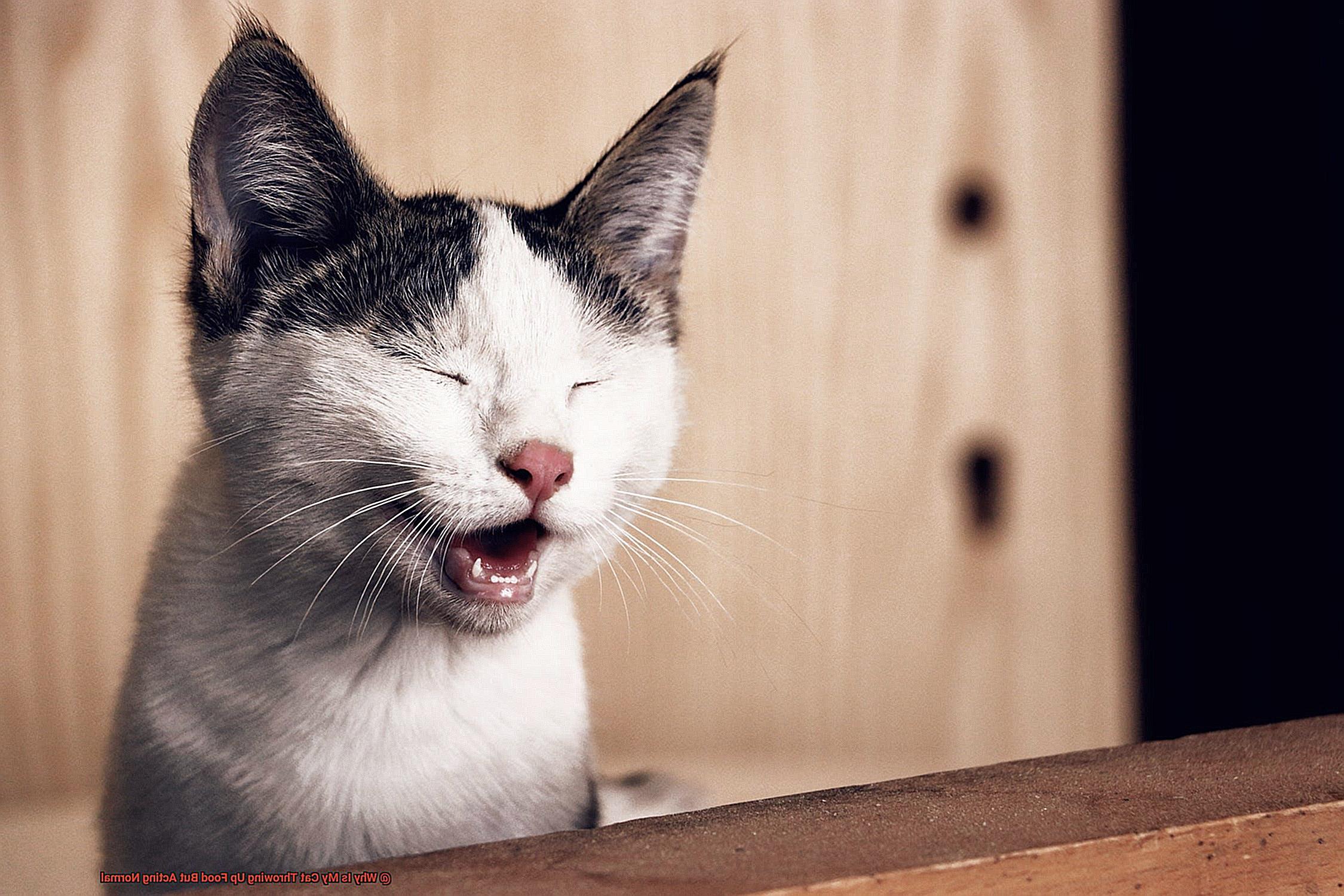
If you suspect that your cat may be suffering from either of these conditions, it’s best to consult with your veterinarian as soon as possible.
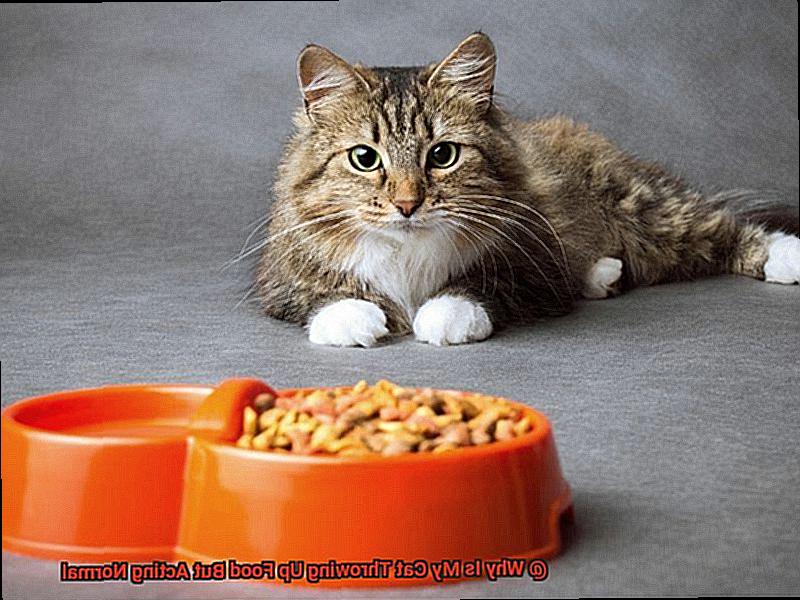
When to Seek Veterinary Care for Vomiting in Cats
While occasional vomiting is normal, frequent vomiting or vomiting combined with other symptoms such as lethargy, diarrhea, or refusal to eat or drink is a red flag.
Consider it as being your kitty’s voice. As a responsible pet parent, it’s our job to recognize when our cats need help and take action accordingly. If you notice any blood in your cat’s vomit or feces or if your cat is experiencing difficulty breathing, seek emergency veterinary care immediately.
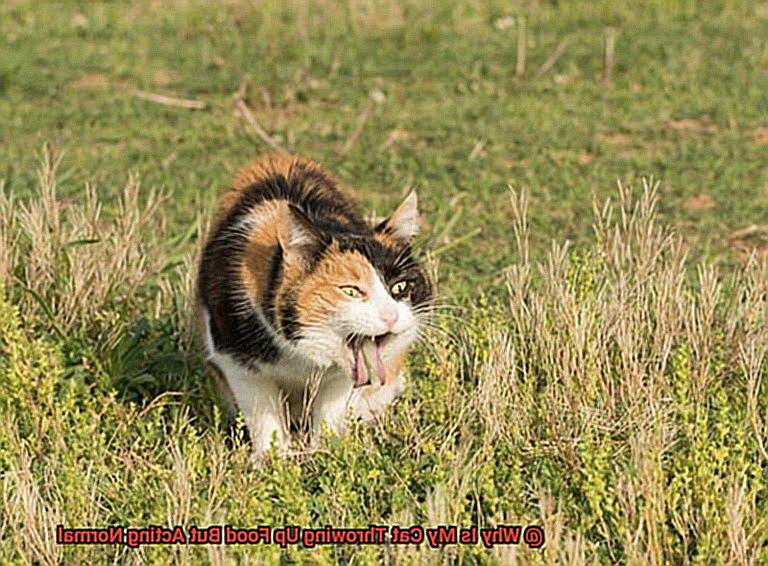
Upon visiting the vet, a comprehensive physical examination will be conducted, and diagnostic tests like blood work, urine analysis, fecal exams, or imaging studies like X-rays or ultrasounds may be recommended to determine the underlying cause of the vomiting. Based on these findings and the clinical history of your cat, the veterinarian will develop a customized treatment plan that may include dietary changes or medications.
Remember that early detection and treatment are essential in preventing complications and maintaining your cat’s overall health and happiness.

So, if you observe any unusual vomiting patterns or behaviors in your furry companion, don’t hesitate to seek veterinary care.
Diet Changes to Help Reduce Vomiting in Cats
Here, we will explore some fascinating dietary changes that can help reduce vomiting in cats.
Switch to an Easy-to-Digest Diet
The first step in reducing vomiting in cats is to switch their diet to one that is easy to digest. Dry food can be difficult for a cat’s digestive system to break down, leading to vomiting. By swapping dry food for wet food or even a raw food diet, you can make it easier on their stomachs and reduce the risk of vomiting.
Choose High-Quality, Natural Cat Food
The quality of your cat’s food also plays a crucial role in reducing vomiting. Low-quality cat food may contain fillers and chemicals that are hard for your cat’s digestive system to process, leading to vomiting. Instead, opt for high-quality, natural cat food that contains wholesome ingredients. This can help reduce the risk of vomiting and improve your cat’s overall health.
Feed Smaller Meals More Frequently
Another factor to consider is the quantity of food your cat consumes. Overeating can lead to vomiting, so it’s important to ensure that you feed smaller meals throughout the day instead of one or two large meals.
This can help prevent overeating and reduce the likelihood of your cat throwing up. Additionally, try using puzzle feeders or slow feeders to encourage your cat to eat more slowly and avoid gulping down their food too quickly.
Make Changes Gradually
Finally, it’s essential to make any dietary changes gradually. Abrupt changes can upset your cat’s stomach and lead to vomiting. A gradual transition over several days or weeks can help your cat adjust and reduce the risk of vomiting. Additionally, always consult with your veterinarian before making any significant changes to your cat’s diet.
Making appropriate dietary changes can significantly reduce vomiting in cats and improve their overall health and wellbeing. By switching to an easy-to-digest diet, choosing high-quality, natural cat food, feeding smaller meals more frequently, and making changes gradually, you can help reduce the likelihood of your feline friend throwing up.
Home Remedies for Cats That Are Throwing Up Food But Acting Normal
There are several home remedies you can try to reduce vomiting and promote healthy digestion.
One effective remedy is to feed your cat smaller, more frequent meals throughout the day. This can prevent overeating and reduce the chances of vomiting. Additionally, adding a small amount of fiber to their diet, such as canned pumpkin or cooked sweet potato, can aid in digestion and soothe their stomach.
Keeping your cat hydrated is also crucial for preventing digestive issues. Encourage them to drink more water by providing fresh water in multiple locations throughout the house and consider adding a water fountain to make it more enticing.
Furthermore, probiotic supplements can be beneficial for promoting healthy gut bacteria and improving digestion. If your cat is experiencing occasional vomiting, try feeding them a bland diet of boiled chicken or rice for a few days to soothe their stomach.
It’s important to remember that if your cat is experiencing frequent or severe vomiting, it’s best to consult with a veterinarian to rule out any underlying health issues.
MVndPT9seFE” >
Common Medications Used to Treat Cat Vomiting
Fortunately, there are a number of medications that veterinarians may prescribe to help tackle this issue. Nevertheless, it’s crucial to bear in mind that medication should only be given under the guidance of a veterinarian to avoid any further health complications.
One of the most commonly prescribed medications for cat vomiting is Cerenia. This highly effective medication works by blocking the action of dopamine, which is the chemical that triggers vomiting. Cerenia is considered safe for cats, but it’s important to note that it should not be used in cats with liver or kidney disease.
Metoclopramide is another medication that your veterinarian may give to your feline friend. It works by stimulating the digestive system and accelerating the movement of food through it, helping to prevent vomiting.

Keep in mind that metoclopramide can cause side effects such as restlessness and diarrhea, so it’s essential to discuss any potential risks with your veterinarian before administering.
In some cases, an anti-inflammatory medication like prednisolone may be prescribed to treat vomiting caused by inflammation or irritation in the gastrointestinal tract. However, long-term use of these medications can have negative side effects and should only be used under close veterinary supervision.
Other medications like famotidine (an antacid), ondansetron (a medication that blocks serotonin), and maropitant (similar to Cerenia) may also be prescribed to alleviate cat vomiting.
Remember that consulting with your veterinarian before giving any medication to your cat is vital as different underlying health conditions may require specific treatment protocols.
Also Read: Why Has My Cat Stopped Eating Dry Food?
Conclusion
In conclusion, it’s crucial to keep an eye on your cat’s vomiting habits. While occasional vomiting is normal, persistent vomiting after eating can be a sign of an underlying health issue. As a responsible pet owner, it’s important to take action when necessary and watch out for any red flags.
The reasons behind your cat’s vomiting can vary from hairballs to more serious health conditions like pancreatitis or inflammatory bowel disease. However, there are several ways to prevent frequent vomiting in cats. You can feed smaller meals more frequently, avoid sudden changes in diet, monitor your cat’s eating habits, keep them hydrated, and reduce stress.
In addition to these preventative measures, there are also home remedies you can try to reduce vomiting and promote healthy digestion. For example, feeding smaller meals throughout the day and adding fiber to their diet can help alleviate symptoms.
If your cat is experiencing frequent or severe vomiting, it’s best to consult with a veterinarian right away. Early detection and treatment are essential in preventing complications and maintaining your cat’s overall health and happiness.
Your vet may prescribe medications like Cerenia or Metoclopramide to alleviate symptoms.







